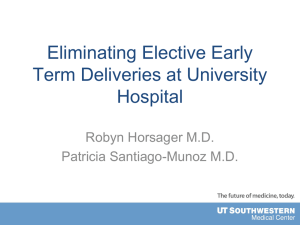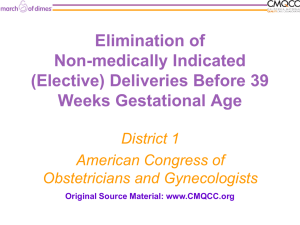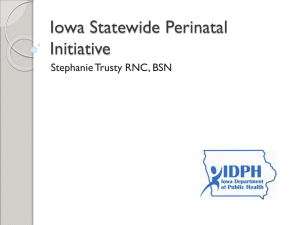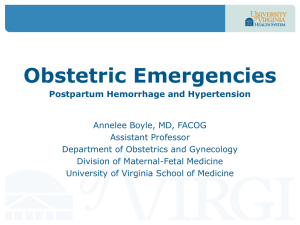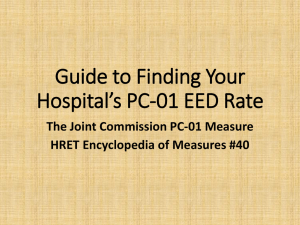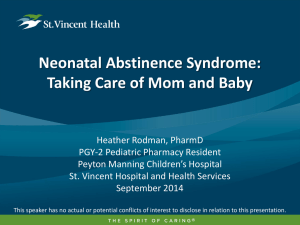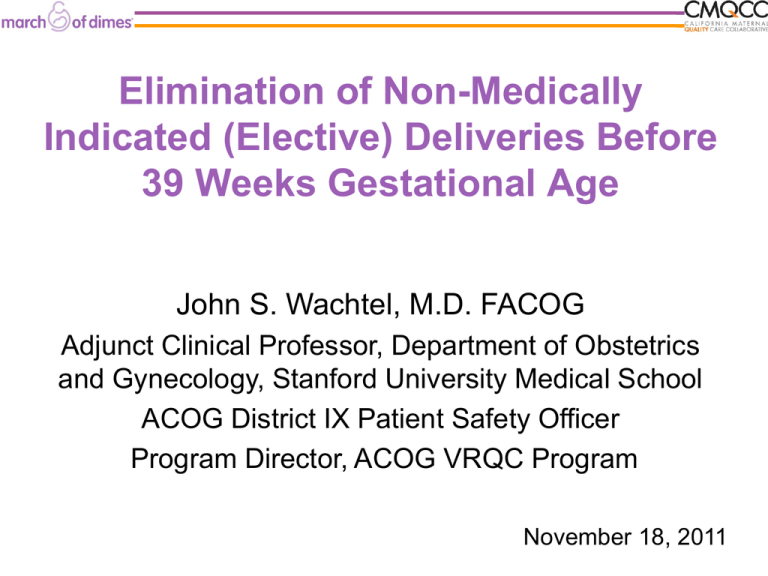
Elimination of Non-Medically
Indicated (Elective) Deliveries Before
39 Weeks Gestational Age
John S. Wachtel, M.D. FACOG
Adjunct Clinical Professor, Department of Obstetrics
and Gynecology, Stanford University Medical School
ACOG District IX Patient Safety Officer
Program Director, ACOG VRQC Program
November 18, 2011
Disclosure Statement
I have no financial interests relevant to this presentation,
but I do serve as an unpaid volunteer on the Executive
Committee of the CMQCC and in several roles for the
March of Dimes.
2
Objectives
1) Describe the increase in non-medically indicated
(elective) deliveries before 39 weeks and identify the
contributing factors.
2) Discuss the risks of early term deliveries and the
benefits of delaying delivery beyond 39 weeks
gestation.
3) Outline successful initiatives to reduce elective
deliveries before 39 weeks at hospital, health system
and statewide levels.
3
Elimination of Non-Medically Indicated (Elective)
Deliveries Prior to 39 Weeks
Funding
Federal Title V block grant
from the California Department
of Public Health; Maternal,
Child and Adolescent Health
Division
California Maternal Quality
Care Collaborative
March of Dimes
4
Acknowledgements
Toolkit Authors:
Elliott Main, MD
Bryan Oshiro, MD
Brenda Chagolla, RN, MSN, CNS
Debra Bingham, Dr.PH, RN
Leona Dang-Kilduff, RN, MSN
Leslie Kowalewski
Author Organizations:
California Maternal Quality Care Collaborative (CMQCC)
California Pacific Medical Center
Loma Linda University School of Medicine
Catholic Healthcare West
California Perinatal Quality Care Collaborative (CPQCC)
March of Dimes
5
“Research has shown that early elective
delivery without medical or obstetrical
indication is linked to neonatal morbidities
with no benefit to the mother or infant.”
6
“There are numerous maternal and fetal
indications for deliveries prior to 39 weeks
gestation.”
7
“In addition… this toolkit… is not meant to
imply that elective deliveries after 39 weeks
have been proven to be without risks for
mothers and infants.”
8
Terminology
Late Preterm Early Term
First day of
LMP
Week #
0
20 0/7
340/7
Preterm
37 0/7 39 0/7
Term
416/7
Post term
Modified from Drawing courtesy of William Engle, MD, Indiana University
Raju TNK. Pediatrics , 2006;118 1207. Oshiro BT Obstet Gynecol 2009;113:804
9
Scheduled Delivery <39 wks in an
Uncomplicated Pregnancy
Since 1979, ACOG has cautioned against
inductions before 39 weeks in the absence of
a medical indication (Committee Opinion #22)
ACOG has also noted that “a mature fetal
lung maturity test result before 39 weeks of
gestation, in the absence of appropriate
clinical circumstances, is not an indication for
delivery”.
(Committee Practice Bulletins #97 and #107)
U.S. Cesarean Section and Labor Induction Rates
Singleton Live Births by Week of Gestation,1992 and 2002
2002 C-S
Early Term
1992 C-S
2002 Induction
1992 Induction
11
Source: NCHS, Final Natality Data, Prepared by March of Dimes Perinatal Data Center, April 2006.
Change in Distribution of Births by Gestational Age:
United States, 1990-2006
Martin JA, Hamilton BE, Sutton PD, Ventura SJ, et al. Births: Final data for 2006. National vital
statistics reports; vol 57 no 7. Hyattsville, MD: National Center for Health Statistics. 2009.
12
Why are non-medically indicated
(elective/planned) deliveries increasing
in frequency?
Elective Induction:
Sounds like a good idea…
Advanced planning
Convenience
Delivered by her doctor
Maternal intolerance to late pregnancy
-
Excess edema, backache, indigestion, insomnia
Prior bad pregnancy
And, it’s okay right?
Clin Obstet Gynecol 2006;49:698-704
14
Obstet Gynecol 2009;114:1254
15
The Gestational Age that Women
Considered a Baby to be “Full Term”
16
Obstet Gynecol 2009;114:1254
The Gestational Age that Women
Considered it “Safe to Deliver”
17
Obstet Gynecol 2009;114:1254
Lots of Pressures on
Obstetricians
Physician Convenience
…what’s the harm?
Guarantee attendance at birth
(“co-dependency”)
Avoid scheduling conflicts
Reduce being woken at night
Bad outcomes are unrecognized and rare
The NICU handles these issues just fine
Limit my risk of a bad pregnancy outcome
And…payment pressures to deliver own pts
Clin Obstet Gynecol 2006;49:698-704
“Non-Medical” Excuses for Inductions
Maternal intolerance to
late pregnancy
Excess edema,
backache, indigestion,
insomnia
-
Prior labor
complication
Prior shoulder dystocia
Suspected fetal
macrosomia
History of rapid labor/
lives far away
Possible lower risk for
mom or baby
-
Lower stillbirth rate,
less macrosomia, less
pre-eclampsia
19
Suspected Fetal Macrosomia
(Non-Diabetic Population)
Does not reduce risk of shoulder dystocia
Doubles risk of cesarean delivery
262 pregnancies EFW >90%
Elective group:
57% cesarean delivery rate
5.3% shoulder dystocia
Spontaneous labor group:
31% cesarean delivery rate
2.5% shoulder dystocia
20
Combs et. al. Obstet Gynecol 1993; 81: 492-496
Risks of Non-Medically Indicated
(Elective) Delivery Before 39
Weeks
“Better a thousand times careful
than once dead.”
ancient proverb
22
Complications of Non-Medically Indicated
(Elective) Deliveries
Between 37 and 39 Weeks
Increased NICU admissions
Increased transient tachypnea of the newborn (TTN)
Increased respiratory distress syndrome (RDS)
Increased ventilator support
Increased suspected or proven sepsis
Increased newborn feeding problems and other
transition issues
See Toolkit for more data and full list of citations
Clark 2009, Madar 1999, Morrison 1995, Sutton 2001, Hook 1997
23
Morbidity of Late Preterm Infants
in Massachusetts
Late preterm infants : 22.2% vs Term infants: 3%
-
Sample: Term (377,638), Late Preterm (26,170)
Morbidity rates doubled for each gestational week
earlier than 38 weeks
40 wks: 2.5%
39 wks: 2.6%
38 wks: 3.3%
37 wks: 5.9%
36 wks: 12.1%
35 wks: 25.6%
34 wks: 51.9%
Shapiro-Mendoza CK et al. Effect of late-preterm birth and maternal medical
conditions on newborn morbidity risk. Pediatrics. 2008;121 :e223 –e232
24
New Concept: U-Shaped Curve
for near-term Neonatal Outcomes
Neonatal outcomes at 37 and 38 weeks
are very similar (or worse) than those at
41 and 42 weeks…
Best outcomes are at 39 and 40 weeks!
NICU Admissions By Weeks Gestation
Deliveries Without Complications, 2000-2003
10%
8%
Percent
6.66%
NICU Admissions
6%
4%
4.26%
3.44%
3.36%
2.47%
2.65%
39th Week
(33,185)
40th Week
(19,601)
2%
0%
37th Week
(8,001)
38th Week
(18,988)
41st Week
(4,505)
42nd Week
(258)
Gestational Weeks
Oshiro et al. Obstet Gynecol 2009;113:804-811.
26
RDS By Weeks Gestation
Deliveries Without Complications, 2000-2003
2.5%
Percent
2.0%
RDS
1.92%
1.5%
1.0%
0.68%
0.67%
0.42%
0.78%
0.41%
0.5%
0.0%
37th Week
(8,001)
38th Week
(18,988)
39th Week
(33,185)
40th Week
(19,601)
41st Week
(4,505)
42nd Week
(258)
Gestational Weeks
Oshiro et al. Obstet Gynecol 2009;113:804-811.
27
Ventilator Usage By Weeks Gestation
Deliveries Without Complications, 2000-2003
2.0%
1.8%
1.6%
Percent
1.4%
1.2%
1.19%
Ventilator Use
1.0%
0.8%
0.47%
0.47%
0.6%
0.4%
0.25%
0.30%
39th Week
(33,185)
40th Week
(19,601)
0.39%
0.2%
0.0%
37th Week
(8,001)
38th Week
(18,988)
41st Week
(4,505)
42nd Week
(258)
Gestational Weeks
Oshiro et al. Obstet Gynecol 2009;113:804-811.
28
Timing of Elective Repeat Cesarean Delivery at
Term and Neonatal Outcomes
13,258 elective repeat cesarean births in
19 centers
35.8% done <39 weeks gestation
Increased risk of neonatal morbidity
-
-
Respiratory, hypoglycemia, sepsis, NICU
admissions, hospitalization > 5 days
Even among babies delivered at 38-39 weeks
Tita AT, et al, NEJM 2009;360:111
29
Adverse Neonatal Outcomes According to Completed
Week of Gestation at Delivery: Absolute Risk
37+ Weeks
16%
38+ Weeks
Percent Affected
14%
39+ Weeks
12%
10%
8%
6%
4%
2%
0%
Any adverse
outcome or death
Adverse
respiratory
outcome(overall)
RDS
TTN
Admission to
NICU
Newborn Sepsis
(suspected or
proven)
30
Tita AT, et al, NEJM 2009;360:111
Timing of Fetal Brain Development
• Cortex volume increases by 50% between 34 and 40
weeks gestation. (Adams Chapman, 2008)
• Brain volume increases at rate of 15 mL/week between
29 and 41 weeks gestation.
• A 5-fold increase in myelinated
white matter occurs between
35-41 wks gestation.
• Frontal lobes are the last to
develop, therefore the most
vulnerable.
31
(Huttenloher, 1984; Yakavlev, Lecours, 1967; Schade, 1961; Volpe, 2001).
Mean IQ Scores in 6 yo Children
from Healthy Term Pregnancies
13,824 healthy term infants followed for an average of 6.5 years. IQ scores adjusted for
multiple factors including: sex, birthweight for gestational age, maternal height and age at birth,
smoking and drinking during pregnancy, parental marital status, number of children in the
household, parental education and occupation.
Yang et al. Am J Epidemiol 2010;171:399-406
Cerebral Palsy among Term and
Postterm Births
CP is 2.3x higher at 37wks
and 1.5x higher at 38 wks
than at 39-41 wks
Norwegian birth cohort of 1,682,441 singleton term births without congenital anomalies followed
for a minimum of 4 years (maximum of 20 years) with identified CP in the National Health
Insurance Registry.
Moster et al. JAMA 2010;304:976-982.
Caveats on CNS Outcomes…
Best outcomes are at 40 weeks.
Note that these studies are associations
and can not show NOT causation.
Nonetheless, the onus is on us to show
that earlier birth is better…
Examples of Successful Programs
to Reduce Non-Medically Indicated (Elective)
Deliveries Before 39 Weeks of Gestation
Magee Women’s Hospital (Pittsburgh)
Intermountain Healthcare (Utah)
Hospital Corporation of America (HCA)
Ohio State Department of Health
35
Magee-Women’s Hospital’s
Experience
Magee-Womens Hospital is the largest maternity
hospital in Western Pennsylvania, performing
more than 9,300 deliveries in 2007.
A rise in the use of induction, reaching a high of
28% in 2003, L&D too busy!
In 2006, a process improvement initiative
changed the induction scheduling process and
strictly enforced the guidelines.
“Elective”: not before 39 weeks and without
cervical ripening agents if 39+0 to 40+6).
Fisch et al Obstet Gynecol 2009;113:797
Magee Women’s Experience with Guidelines
Baseline
3mos
2004
Voluntary
3mos
2005
Enforced
14mos
2006-7
Deliveries
2,139
2,260
10,895
Elective Inductions <39wks (N)
Elective Inductions <39wks (rate)
23
11.8%
21
10.0%
30
4.3%
(p<0.001)
Elective Nullip Inductions (N)
Elective Nullip Inductions =>C/S (N)
Elective Nullip Inductions =>C/S
(rate)
29
10
35.7%
33
5
15.2%
87
12
13.8%
(p<0.01)
Total Induction Rate
24.9%
20.1%
16.6%
(elective inductions <39 / total elective
inductions)
37
Fisch et al Obstet Gynecol 2009;113:797
Magee Women’s Experience
“The importance of strong physician and nursing
leadership cannot be overstated. The change in
the induction scheduling process that began to
enforce the guidelines strictly in late 2006 was
spearheaded by the OB Process Improvement
Committee, whose members included the
hospital’s Vice President for Medical Affairs, the
Medical Director of the Birth Center, and the
nursing leadership for the Birth Center.”
Fisch et al Obstet Gynecol 2009;113:797
Intermountain Healthcare’s Experience
Intermountain Healthcare is a vertically integrated
healthcare system that operates 21 hospitals in
Utah and Southeast Idaho and delivers
approximately 30,000 babies annually.
Computerized L&D system.
MFMs hired by system, but OBs are independent.
January 2001: 9 urban facilities participated in a
process improvement program for elective
deliveries.
28% of elective deliveries were occurring before 39
completed weeks of gestation.
39
Oshiro, B. et al. Obstet Gynecol 2009;113:804-811.
% Non-Medically Indicated Deliveries
<39 Weeks, January 1999 – December 2005
40
Oshiro, B. et al. Obstet Gynecol 2009;113:804-811.
Common Themes Noted in
Intermountain Healthcare’s Experience
Education provided to obstetricians regarding ACOG
guidelines, best practice.
Little change until physicians were held accountable,
nurses were empowered, and guidelines were
enforced.
Medical leadership critical.
41
Oshiro, B. et al. Obstet Gynecol 2009;113:804-811.
“Reduction in elective delivery at <39 weeks of gestation:
comparative effectiveness of 3 approaches to change
and the impact on neonatal intensive care admission
and stillbirth”
HCA: Largest healthcare system in the US with approx
220,000 births annually.
Cohort study of 27 pilot hospitals in 2007-2009
42
Clark SL. et al. Am J Obstet Gynecol 2010;203:449.e1-6
HCA Study Design
Self-selected to either:
Group 1—”Hard stop”, staff refuses to schedule <39 wk elective
procedures, exceptions through chain of command
Group 2—”Soft stop”, compliance left to individual physicians,
cases reviewed in peer review sessions
Group 3—”Education only”, provision of literature and ACOG
recommendations
Careful distinction among “planned” deliveries between
“indicated” and “elective” deliveries
43
Clark SL. et al. Am J Obstet Gynecol 2010;203:449.e1-6
HCA Trial of 3 Approaches for
Reduction of Elective Deliveries <39 weeks
Hard Stop
Soft Stop/
Peer Rev
Education
Only
P=0.135
P=0.025
P=0.007
44
Clark SL. et al. Am J Obstet Gynecol 2010;203:449.e1-6
Neonatal Outcomes for HCA Trial
Stillbirth Rate unchanged:
2007: 0.69%
2009: 0.71%
Not significant
Term NICU Admissions:
2007: 8.9%
2009: 7.5% (decreased 16%)
P<0.001
RR=0.85
45
Common Themes
All started with education provided to
obstetricians regarding ACOG guidelines and
best practices.
Modest change at most, until physicians were
held accountable, nurses were empowered,
and guidelines were enforced (“Hard stop”).
Medical leadership important.
Timely access to data rates acts as
motivator.
Alleviating Obstetricians’ Fears About
Delaying Delivery
Obstetricians in several of these studies voiced
concerns regarding a potential increase in perinatal
mortality and maternal morbidity.
47
Stillbirths Before and After Implementation of
Guidelines at Intermountain Healthcare
48
Oshiro, B. et al. Obstet Gynecol 2009;113:804-811.
Wouldn’t Keeping Women Pregant Longer
Increase Their Risk of Adverse Outcomes?
The experience in Ohio and Utah has shown that
morbidity remained the same for macrosomia, preeclampsia and maternal infections.
Decreases were seen in stillbirth, low apgar scores,
cesarean section for fetal distress, meconium
aspiration and postpartum anemia.
49
Summary:
Reasons to Eliminate Non-Medically Indicated
(Elective) Deliveries Before 39 Weeks
Reduction of neonatal complications
No harm to mother if no medical or obstetrical
indication for delivery
Now a national quality measure:
-
National Quality Forum (NQF)
-
Leapfrog Group
-
The Joint Commission (TJC)
50
“Out of this nettle, danger, we pluck this
flower, safety.”
William Shakespeare
51

